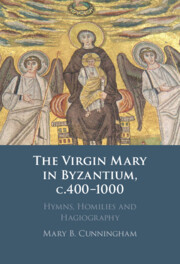Book contents
- The Virgin Mary in Byzantium, c. 400–1000
- The Virgin Mary in Byzantium, c. 400–1000 CE
- Copyright page
- Dedication
- Contents
- Acknowledgements
- Additional material
- A Note on Capitalisation, Spelling and Recent Publications
- Introduction
- Chapter 1 Praise of Mary in Song: The Early Hymnography
- Chapter 2 From Theotokos to Intercessor: The Early Homiletic Witness (c. 400–600)
- Chapter 3 Panegyrics and Supplication: Homilies from c. 600 to 1000
- Chapter 4 Theology in Verse: Middle Byzantine Hymnography
- Chapter 5 Narratives about the Panagia
- Conclusion
- Bibliographies
- Index
- References
Bibliographies
Published online by Cambridge University Press: 20 August 2022
- The Virgin Mary in Byzantium, c. 400–1000
- The Virgin Mary in Byzantium, c. 400–1000 CE
- Copyright page
- Dedication
- Contents
- Acknowledgements
- Additional material
- A Note on Capitalisation, Spelling and Recent Publications
- Introduction
- Chapter 1 Praise of Mary in Song: The Early Hymnography
- Chapter 2 From Theotokos to Intercessor: The Early Homiletic Witness (c. 400–600)
- Chapter 3 Panegyrics and Supplication: Homilies from c. 600 to 1000
- Chapter 4 Theology in Verse: Middle Byzantine Hymnography
- Chapter 5 Narratives about the Panagia
- Conclusion
- Bibliographies
- Index
- References
Summary
Information
- Type
- Chapter
- Information
- The Virgin Mary in Byzantium, c.400–1000Hymns, Homilies and Hagiography, pp. 219 - 265Publisher: Cambridge University PressPrint publication year: 2022
- Creative Commons
- This content is Open Access and distributed under the terms of the Creative Commons Attribution licence CC-BY-NC-ND 4.0 https://creativecommons.org/cclicenses/
